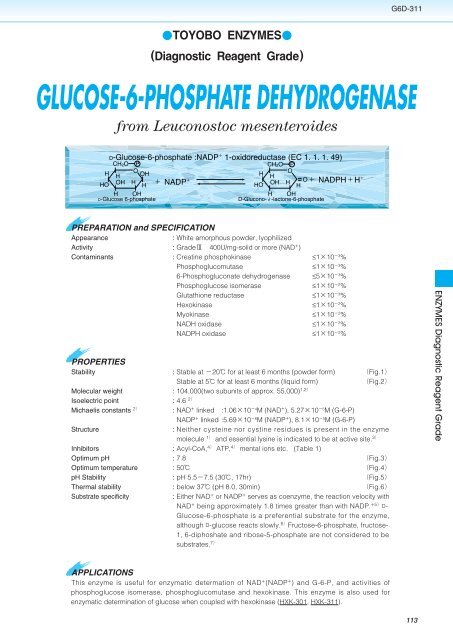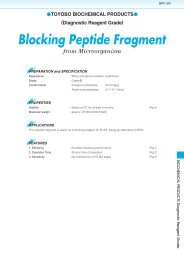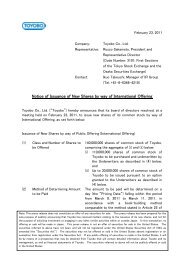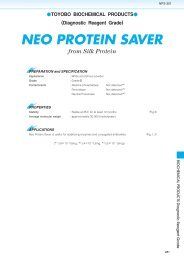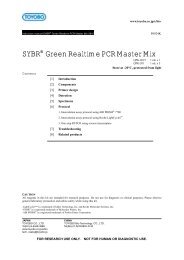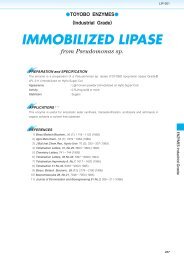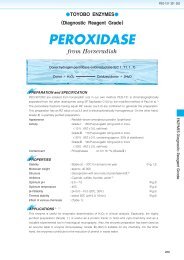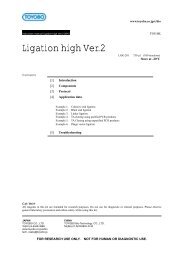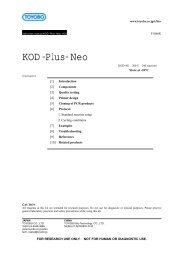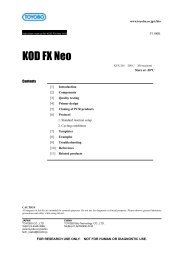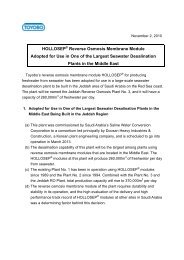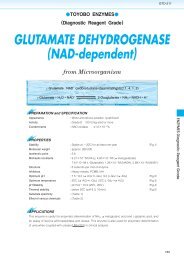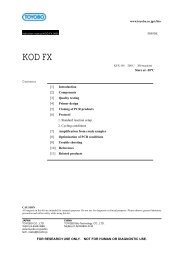GLUCOSE-6-PHOSPHATE DEHYDROGENASE - Toyobo
GLUCOSE-6-PHOSPHATE DEHYDROGENASE - Toyobo
GLUCOSE-6-PHOSPHATE DEHYDROGENASE - Toyobo
Create successful ePaper yourself
Turn your PDF publications into a flip-book with our unique Google optimized e-Paper software.
G6D-311TOYOBO ENZYMES(Diagnostic Reagent Grade)<strong>GLUCOSE</strong>-6-<strong>PHOSPHATE</strong> <strong>DEHYDROGENASE</strong>from Leuconostoc mesenteroidesD-Glucose-6-phosphate :NADP 1-oxidoreductase (EC 1. 1. 1. 49)CH2O P CH2O PO OH OHH H HOH H NADP ONADPHH OH HHOHHOHH OHH OHD-Glucose 6-phosphateD-Glucono--lactone-6-phosphatePREPARATION and SPECIFICATIONAppearance: White amorphous powder, lyophilizedActivity : Grade400U/mg-solid or more (NAD )Contaminants : Creatine phosphokinase ≤110 3 %Phosphoglucomutase ≤110 3 %6-Phosphogluconate dehydrogenase ≤510 3 %Phosphoglucose isomerase ≤110 2 %Glutathione reductase ≤110 3 %Hexokinase ≤110 2 %Myokinase ≤110 2 %NADH oxidase ≤110 2 %NADPH oxidase ≤110 2 %PROPERTIESStability : Stable at 20 for at least 6 months (powder form) Fig.1Stable at 5 for at least 6 months (liquid form)Fig.2Molecular weight : 104,000(two subunits of approx. 55,000) 1,2Isoelectric point: 4.6 2Michaelis constants 2 : NAD linked :1.0610 4 M (NAD ), 5.2710 5 M (G-6-P)NADP linked :5.6910 6 M (NADP ), 8.110 5 M (G-6-P)Structure: Neither cysteine nor cystine residues is present in the enzymemolecule 1 and essential lysine is indicated to be at active site. 3Inhibitors : Acyl-CoA, 4 ATP, 4 mental ions etc. (Table 1)Optimum pH : 7.8 Fig.3Optimum temperature : 50 Fig.4pH Stability : pH 5.57.5 (30, 17hr) Fig.5Thermal stability : below 37 (pH 8.0, 30min) Fig.6Substrate specificity: Either NAD or NADP serves as coenzyme, the reaction velocity withNAD being approximately 1.8 times greater than with NADP. 5 D-Glucose-6-phosphate is a preferential substrate for the enzyme,although D-glucose reacts slowly. 6 Fructose-6-phosphate, fructose-1, 6-diphoshate and ribose-5-phosphate are not considered to besubstrates. 7APPLICATIONSThis enzyme is useful for enzymatic determation of NAD (NADP ) and G-6-P, and activities ofphosphoglucose isomerase, phosphoglucomutase and hexokinase. This enzyme is also used forenzymatic determination of glucose when coupled with hexokinase (HXK-301, HXK-311).113
G6D-311ASSAYPrinciple:D-Glucose-6-phosphate(G-6-P)NAD glucose-6-phophate dehydrogenase(G-6-PDH)D-Glucono--lactone-6-phosphateNADHH The appearance of NADH is measured at 340nm by spectrophotometry.Unit definition:One unit causes the formation of one micromole of NADH per minute under the conditions described below.Method:ReagentsA. Tris-HCl buffer, pH 7.8B. NAD solutionC. G-6-P solutionD. Enzyme diluent55mM (contaning 3.3mM magnesium chloride)60mM (Should be prepared fresh)0.1M glucose-6-phosphate (Should be prepared fresh)5mM Tris-HCl buffer, pH 7.5, containing 0.1% of bovine serum albumin.Procedure1. Prepare the following reaction mixture in a cuvette (d1.0cm)Concentration in assay mixtureand equilibrate at 30 for about 5 minutes.Tris-HCl buffer50 mM2.7ml Tris-HCl buffer, pH 7.8 (A) G-6-P3.3 mMNAD 2.0 mM0.1ml NAD solution (B)MgCl 23.0 mM0.1ml G6P solution (C)BSA33g/ml2. Add 0.1ml of the enzyme solution and mix by gentle inversion.3. Record the increase in optical density at 340nm against water for 4 to 5 minutes in a spectrophotometerthermostated at 30 and calculate the OD per minute from the initial linear portion of the curve (ODtest).At the same time, measure the blank rate (OD blank) by using the same method as the test except thatthe enzyme diluent is added instead of the enzyme solution.Dissolve the enzyme preparation in ice-cold enzyme diluent (D) and dilute to 0.050.20U/ml with the samebuffer, immediately before the assay.CalculationActivity can be calculated by using the following formulaOD/min (OD testOD blank)VtdfVolume activity (U/ml) 6.221.0VsWeight activity (U/mg)(U/ml)1/CVt Total volume (3.0ml)Vs Sample volume (0.1ml)6.22 Millimolar extinction coefficient of NADH (F/micromole)1.0 Light path length (cm)df Dilution facterC Enzyme concentration in dissolution (c mg/ml)OD/min4.82dfREFERENCES1) A.Ishaque,M.Mihausen and H.R.Levy; Biochem. Biophys. Res. Comm., 59, 894 (1974).2) C. Olive, M.E. Geroch and H.R.Levy; J.Biol.Chem., 246, 2043 (1971).3) M.Milhausen and H.R. Levy; Eur.J.Biochem., 50, 453 (1975).4) E.L.Coe and L.-H.Hsu; Biochem. Biophys. Res. Comm., 53, 66 (1973).5) C.Olive and H.R. Levy; Biochem., 6, 730 (1967).6) R.P.Metzger, S.A. Metzger and R.L. Parsons; Arch Biochem. Biophys., 149, 102 (1972).7) Methods in Enzymology, Vol, 1, p328 (S.P.Colowick and N.O.Kapalan,eds.), Academic Press, New York(1955).114
G6D-311Table 1. Effect of Various Chemicals on Glucose-6-phosphate dehydrogenaseThe enzyme dissolved in 50mM Tris-HCl buffer,pH 7.5 (5.25U/ml) was incubated with eachchemcal for 1hr at 30.Chemical Concn.(mM)ResidualactivityNone 100%Metal salt 2.0AgNO 3 86Ba(OAc) 2 51CaCl 2 90Cd(OAc) 2 74CoCl 2 80CuSO 4 66FeCl 3 0FeSO 4 1HgCl 2 84MgCl 2 90MnCl 2 89NiCl 2 89Pb(OAc) 2 3Zn(OAc) 2 67ZnSO 4 53KF 2.0 93NaF 20.0 98NaN 3 20.0 93ChemicalConcn.(mM)Ac, CH 3 CO; NEM, N-Ethylmaleimide; PCMB, p-Chloromercuribenzoate; MIA, Monoiodoacetate; EDTA,Ethylenediaminetetraacetate; SDS, Sodium dodecyl sulfate; DAC, Dimethyl-benzyl-alkyl-ammoniumchlorideResidualactivityNEM 2.0 91PCMB 2.0 96MIA 2.0 14Iodoacetamide 2.0 0EDTA 5.0 94(NH 4) 2SO 4 20.0 98Borate 20.0 95o-Phenanthroline 2.0 93,´-Dipyridyl 2.0 95Urea 2.0 93Guanidine 2.0 93Hydroxylamine 2.0 91Na-cholate 1.0%102Triton X-100 1.0%100Brij 35 1.0%4SDS 0.1%0Tween 20 0.1%101Span 20 0.1%99DAC 0.1%0100100100Residual Activity,%50-205Relative Activity50Residual Activity,%500 3 6 12Period (months)Fig.1. Stability (Powder form)kept under dry conditions1000 6 7 8 9 10pHFig.3. pH-Activity30 in the following buffer solution:pH5.7-6.8, 15mM Veronal-CH3COONa-HCI;pH6.8-8.5,50mM Tris-HCI;pH8.5-9.5, 50mM glycine-NaOH1000 5 6 7 8 9 10pHFig.5. pH-Stability30, 17hr-treatment with the followingbuffer solution: pH5.0-7.8, 30mM Veronal-CH3COONa-HCI;pH7.5-8.5, 0.1M Tris-HCI;pH8.5-9.5,0.1M glycine-NaOH100Residual Activity,%50Relative Activity50Residual Activity, %500 2 4 6 8Period(months)Fig.2. Stability (Liquid form at 5)enzyme concentration:5,000U/mlcomposition:3.2M ammoniumsulfate,pH6.00 20 30 40 50 60Temperature, Fig.4. Temperature activityin 50mM Tris-HCI buffer,pH7.80 20 30 40 50 60Temperature, Fig.6. Thermal stability30min-treatment with 5.0mM glycine-NaOH buffer, pH8.0, containing 0.1% ofbovine serum albumin115
G6D-311 glucose-6-phosphate dehydrogenase (G-6-PDH) 2 PP P P P PPPP P F P116


